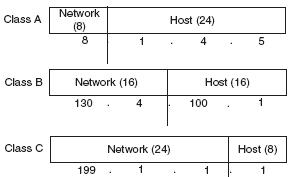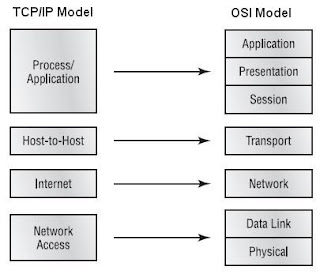To identify the system on a network is called IP address, it is a logical
address, it is a network layer (layer3) address.
There are Two type of IP address
1. IP version 4 (32 bit)
2. IP version 6 (128 bit)
----------------------------------------------------------------------------------------------
IP version 4
IPv4 addresses are 32 bits long, broken up into 4 bytes, and separated by decimals, commonly called the dotted decimal format. Two components make up the address: a network and host number.
In IPv4 there are total five classes : Class A, Class B, Class C, Class D, Class E
Class A addresses have, by defaults, 8 network bits, Class B addresses have 16 bits, and Class C addresses have 24 network bits
IP Address Components
Two components make up a Class A, B and C IP Address: network and host. The host portion is actually broken into three subcomponents: the network address, the host address, and the directed broadcast address.
* There are certain addresses in each class of IP address that are reserved for Private Network. These addresses are called private addresses
* These addresses are not Routable or valid on internet.
IPv4 Address Type
* Unicast
* Broadcast
* Multicast
-----------------------------------------------------------------------------------------------------
IP version 6
IPv4 address is 32 bits in length, there 232 actual IP address, which is 4.3 billion addresses. Not all of these are usable, however: only 3.7 billion of these are actually usable. Many addresses are reserved, such as
* Research (239-254)
* Broadcast (255)
* Multicast (224-239)
* Private (10,172.16, and 192.168)
* Loopback addresses (127)
Unlike 32 bit IPv4 addresses, IPv6 uses a 128 bit address. This allows for 3.4 x 1038 addresses, which is enough for many IP addresses for each person on Earth, and probably multiple planets.
IPv6 Features
* Very large address space
* Security
* Mobility
* Streamlined encapsulation
* Transition capabilities
Example of IPv6 addressing
IPv6 Address Type
* Unicast Address
* Global Unicast Address
* Link-local Address
* Unique Local Address
* Multicast Address
* Anycast Address
Special Addresses of IPv6
1. 0:0:0:0:0:0:0:0 Equals :: =>This is the equivalent of IPv4`s 0.0.0.0, and is typically the source address of a host when you are using state full configuration.
2. 0:0:0:0:0:0:0:1 Equals ::1 =>The equivalent of 127.0.0.1 in IPv4
3. 0:0:0:0:0:0:192.168.100.1 => This is how an IPv4 address would be written in a mixed IPv6/IPv4 network environment.
4. 2000::/3 =>The global unicast address range.
5. FC00::/7 => The unique local unicast range.
6. FE80::/10 => The link-local unicast range.
7. FF00:/8 => The multicast range
8. 3FFF:FFFF::/32 => Reserved for example and documentation
9. 2001:0DB8::/32 => Also reserved for examples and documentation
10. 2002::/16 => Used with 6to4, which is the transition system.
There are Two type of IP address
1. IP version 4 (32 bit)
2. IP version 6 (128 bit)
----------------------------------------------------------------------------------------------
IP version 4
IPv4 addresses are 32 bits long, broken up into 4 bytes, and separated by decimals, commonly called the dotted decimal format. Two components make up the address: a network and host number.
In IPv4 there are total five classes : Class A, Class B, Class C, Class D, Class E
Class A addresses have, by defaults, 8 network bits, Class B addresses have 16 bits, and Class C addresses have 24 network bits
IP Address Components
Two components make up a Class A, B and C IP Address: network and host. The host portion is actually broken into three subcomponents: the network address, the host address, and the directed broadcast address.
an IP address that begins with 8 in the first octet is in a
Class A network, so the network part of the address is the first byte, or first
octet. An address that begins with 130 is in a Class B network. By definition,
Class B addresses have a 2-byte network part, as shown. Finally, any address
that begins with 199 is in a Class C network, which has a 3-byte network part.
Also by definition, a Class A address has a 3-byte host part, Class B has a
2-byte host part, and Class C has a 1-byte host part.
All Possible Valid Network Numbers
Public and Private Addressing
The ICANN (formerly IANA) and its member organizations
manage the process of assigning IP network numbers, or even smaller ranges of IP
addresses, to companies that want to connect to the Internet. After a company is
assigned a range of IP addresses, only that company can use that range.
Additionally, the routers in the Internet can then learn routes to reach these
networks, so that everyone in the entire Internet can forward packets to that IP
network. Because these IP addresses can be reached by packets in the public
Internet, these networks are often called public networks, and the addresses in
these networks are called public addresses.
Private Address Space* There are certain addresses in each class of IP address that are reserved for Private Network. These addresses are called private addresses
* These addresses are not Routable or valid on internet.
IPv4 Address Type
* Unicast
* Broadcast
* Multicast
-----------------------------------------------------------------------------------------------------
IP version 6
IPv4 address is 32 bits in length, there 232 actual IP address, which is 4.3 billion addresses. Not all of these are usable, however: only 3.7 billion of these are actually usable. Many addresses are reserved, such as
* Research (239-254)
* Broadcast (255)
* Multicast (224-239)
* Private (10,172.16, and 192.168)
* Loopback addresses (127)
Unlike 32 bit IPv4 addresses, IPv6 uses a 128 bit address. This allows for 3.4 x 1038 addresses, which is enough for many IP addresses for each person on Earth, and probably multiple planets.
The 128-bit IPv6 address is written in
hexadecimal notation, with colons between each quartet of symbols. Even in
hexadecimal, the addresses can be long. However, IPv6 also allows for
abbreviations, The table also summarizes some of the pertinent information
comparing IPv4 addresses with IPv6.
IPv4 Versus IPv6IPv6 Features
* Very large address space
* Security
* Mobility
* Streamlined encapsulation
* Transition capabilities
Example of IPv6 addressing
IPv6 Address Type
* Unicast Address
* Global Unicast Address
* Link-local Address
* Unique Local Address
* Multicast Address
* Anycast Address
Special Addresses of IPv6
1. 0:0:0:0:0:0:0:0 Equals :: =>This is the equivalent of IPv4`s 0.0.0.0, and is typically the source address of a host when you are using state full configuration.
2. 0:0:0:0:0:0:0:1 Equals ::1 =>The equivalent of 127.0.0.1 in IPv4
3. 0:0:0:0:0:0:192.168.100.1 => This is how an IPv4 address would be written in a mixed IPv6/IPv4 network environment.
4. 2000::/3 =>The global unicast address range.
5. FC00::/7 => The unique local unicast range.
6. FE80::/10 => The link-local unicast range.
7. FF00:/8 => The multicast range
8. 3FFF:FFFF::/32 => Reserved for example and documentation
9. 2001:0DB8::/32 => Also reserved for examples and documentation
10. 2002::/16 => Used with 6to4, which is the transition system.













